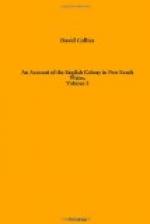The hills descend with such gentle slopes, that the valleys between them are extensive and flat. Several contain an indeterminate depth of rich soil, capable of supporting the most exhausting vegetation, and are tolerably well watered by chains of small ponds, or occasional drains, which empty themselves into the river by a cove or creek.
One mountain to the west, lying about three miles from the water, and so remarkably conspicuous as to be seen from every part of the Derwent and its vicinity, Mr. Bass ascended; and he was much surprised to find it abounding with fine tall gum-tree timber uncommonly straight.
The shore on the east side of the river, proceeding up, is covered with a good but shallow soil, and lightly wooded; cultivable for the greater part with any kind of grain, and the whole fit for pasturage, though, perhaps, not sufficiently watered for large cattle which require much drink.
On the west side the country rises too suddenly into stony hills to be in general so good as in most other places. It would, however, afford tolerable pasturage; and a few patches of eighty or one hundred acres each were excellent arable land.
The shore here, as in many other parts of the river, exhibited signs of internal or subterraneous disturbance. The strata of cliffs were broken and disjoined, lying sloping in different directions. Near a small point several pieces of petrified wood, and lumps of stone of every kind and every size, were enveloped, or rather stuck into the matter of the rock, which, although in colour much like a yellow tinged clay, yet had the usual rough porous surface peculiar to substances that have been in a state of fusion. It was here, as in other places, hard, but did not scintillate with steel, and was divided, by lines of a still harder iron-tinged stone, into squares and parallelograms of various sizes. From one of these intersecting lines, Mr. Bass took a small lump of this ferruginous stone, that seemed to have bubbled up, and to have hardened in the form of an ill-shaped bunch of small grapes. Some of the neighbouring cliffs, for several yards, were formed into basaltic columns.
In walking across one of the steep heads between two small bays, he met with a large deep hole in the ground, that appeared to have been occasioned by the falling-in of the earth which had formerly occupied its space. Its extent was about twenty-two yards by seventeen; its depth perhaps sixty feet. The sides were not excavated, but rather smooth and perpendicular. They were rocks of the same yellow tinge as those of the shore. A little surf that washed up within it showed a communication with the river, by a narrow subterraneous passage of some ten or sixteen feet in height, and, according to the distance of the hole from the edge of the cliff, about thirty-five yards in length. Appearances seemed to agree, that the period at which this earth fell in could not be very remote.




